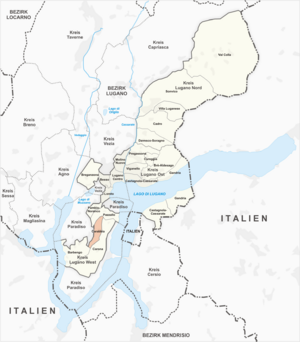Carabbia facts for kids
Quick facts for kids
Carabbia
|
||
|---|---|---|
|
Quarter
|
||
|
||
 |
||
| Country | Switzerland | |
| Canton | Ticino | |
| District | Lugano | |
| City | Lugano | |
| Area | ||
| • Total | 1.07 km2 (0.41 sq mi) | |
| Population
(2012-12-31)
|
||
| • Total | 606 | |
| • Density | 566.4/km2 (1,467/sq mi) | |
Carabbia is a lovely area, or quarter, that is part of the big city of Lugano in Switzerland. It's a bit like a neighborhood within a larger town.
Carabbia wasn't always part of Lugano. For a long time, it was its own small town, called a municipality. It was founded way back in 1213, which means it has a lot of history!
In 2008, Carabbia officially joined Lugano. This means it became a part of the larger city. Now, it's one of Lugano's many interesting quarters.
Contents
Discovering Carabbia
Carabbia is located in the beautiful Ticino region of Switzerland. This area is known for its stunning mountains and lakes. It's a great place to explore nature.
Where is Carabbia?
Carabbia is found in the Lugano District. This district is part of the larger Ticino canton. A canton is like a state or a province in Switzerland.
The city of Lugano is one of the biggest cities in Ticino. Carabbia helps make Lugano even larger and more diverse.
How Big is Carabbia?
Carabbia is a relatively small quarter. It covers an area of about 1.07 square kilometers. That's roughly the size of 150 football fields!
In 2012, about 606 people lived in Carabbia. This makes it a cozy community within the bustling city of Lugano.
Carabbia's History
Carabbia has a long and interesting past. Being founded in 1213 means it has seen many centuries of changes. Imagine what life was like there hundreds of years ago!
From Municipality to Quarter
For centuries, Carabbia managed its own local affairs. It had its own local government and made decisions for its residents. This is what it means to be a municipality.
In 2008, the people of Carabbia voted to join Lugano. This decision helps the area get better services and be part of a bigger community. It's a common way for smaller towns to grow and develop.


